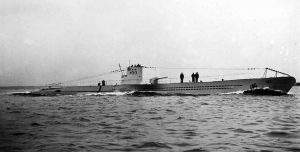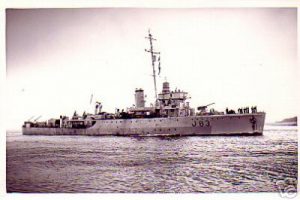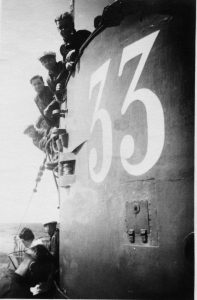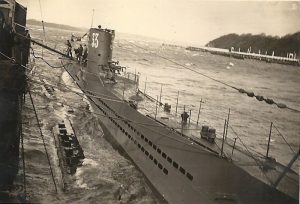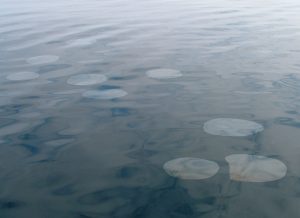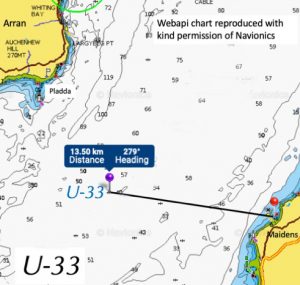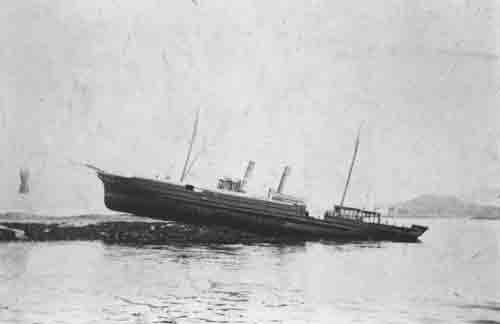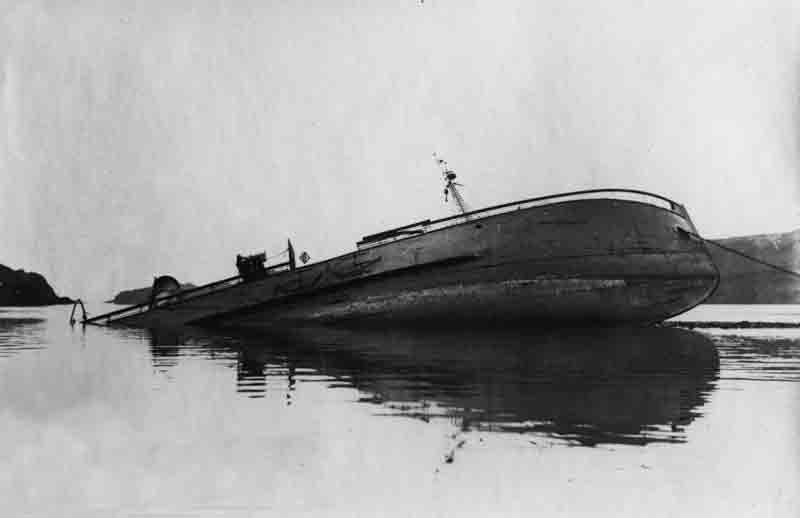The German submarine U-33 was a type VIIA U-boat, part of Germany’s Kriegsmarine during World War II. She was built Germaniawerft at Keil (Yard No 556) and launched on 11th June 1936 and commissioned on 25th July. Her dimensions were 211.7′ x 19.1′ x 14.2′ and she had a displacement of 745 tons. She was armed with 5 torpedo tubes, four bow and one stern, a single deck gun forward of the conning tower and one AA gun. She was able to either fire torpedoes or lay mines from her tubes.
The short career of the U-33 had included two sorties into the seas around Britain in 1939. During her first cruise, in the Western Approaches, she sank three British steamships, was attacked twice by aircraft and gathered ten iron crosses for members of her crew. On her second cruise, in the Bristol Channel, her role was to lay mines although she managed to sink five trawlers and a German prize ship being towed into a British port before returning to Wilhelmshaven and a major refit.
The U-33 left Wilhelmshaven for her final, fatal voyage on 5th February, 1940 under the command of Kapitanleutnant Hans von Dresky with her crew of forty. Her daring, almost suicidal task, which had been directly ordered by Hitler himself, was to lay mines in one of the Allies most important seaways, the River Clyde. Their route took them north through the North Sea and west into the Atlantic before turning south and heading for their target. The atmosphere on board was tense as they beat their way southwards into a pounding Atlantic gale. The crew knew the danger they faced as they entered the lion’s den that was the most important Allied anchorage on the Atlantic coast. Finally, on 12th February, they arrived off the Clyde giving them some relief from the sickening rolling caused by the huge swell on their beam.
The same evening HMS Gleaner, a Royal Navy minesweeper, was on her patrol in the Clyde under the command of Lieutenant Commander Hugh Price. Their patrol area covered a triangle south of Arran with the northerly tip at Pladda lighthouse. At 2:50am they made their first hydrophone contact with U-33. At their commander’s order the crew leapt into action and the deadly game of cat and mouse between the German Kapitanleutnant and the British Lieutenant Commander began. Within minutes the Gleaner’s four inch guns and her depth charges were cleared for action with crews standing by. It was to be a long, cold night. Unfortunately, just as quickly as they found it, they lost contact with the submarine and had to begin a nerve tingling sweep search in an attempt to locate their prey once more. Twenty minutes later, just as the shivering crew on deck were beginning to think they had lost her, a shout from the sonar operator indicated that they re-established contact and the white spray tail of the enemy periscope was caught in the searchlight beam. The Gleaner homed in on the spot at full speed.
On board U-33 the Kapitanleutnant ordered engines stopped and the forty German sailors sweated and prayed in silence as they settled to the seabed and lay motionless listening to the insistent rattle of the Asdic beam on the hull. Their painful silence was shattered by the huge explosion of the first pattern of depth charges – a near miss on the starboard side which strained the groaning plates of the submarine and fired ruptured rivets like bullets across the darkness inside their vessel. They lay still and silent on the seabed as the frozen hands of the British seamen wrestled with the next set of depth charges on the deck of the Gleaner. The second pattern battered the U-boat once more, rupturing her main tanks, but still they survived. This time, agonisingly for the British, the Gleaner lost contact in the disturbed water after the explosions, but the German Commander lost his chance of escape by not moving at this time. Ten minutes later contact was re-established once more and a third pattern of charges brought the U-33 to the surface, the cold, frightened crew huddled in the conning tower in surrender. As the Gleaner closed in to pick up its prisoners, all the while expecting a trick of some sort, an explosion flashed across the dark night, rocking the submarine. The German Commander had set off preset dynamite charges scuttling his vessel and leaving his crew to jump for their lives into the cold waters of the Clyde. The U-33 slipped slowly beneath the surface, diving to the depths for the last time. It had been almost three hours from the first contact. The Gleaner, and a number of other craft which had arrived on the scene by this time, cruised around and picked up twenty sodden survivors and a number of bodies which were later buried in a communal grave in Greenock cemetery.
The wreck of the U-33 lies in 58 metres of water five miles south of Pladda in position 55° 21.483’N, 005° 01.683’W and rises 3-4 metres above the seabed. She is oriented 100°/180° with her bows pointing east towards the Ayrshire coast. The U-33 is sitting upright on the seabed, her hull is intact and her conning tower is the highest part of the wreck with her deck gun is still in place forward of the tower.
